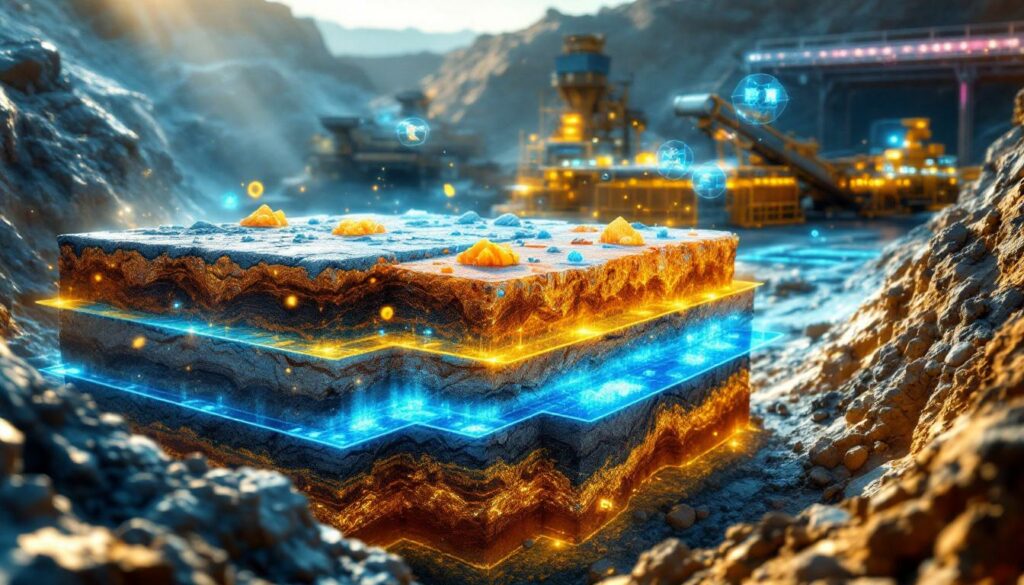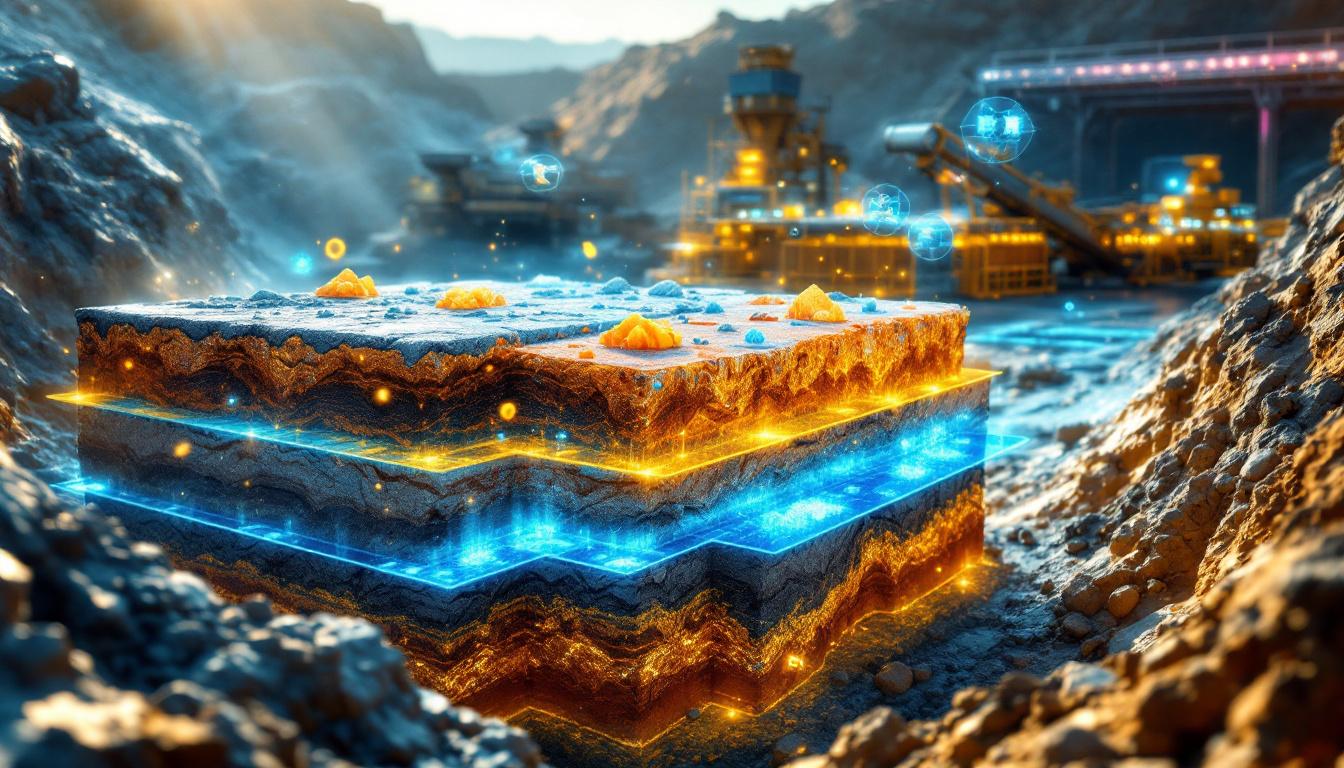What is Geometallurgy and Why Does It Matter?
Geometallurgy represents the integration of geological understanding with metallurgical performance prediction. Rather than treating these disciplines as separate entities, geometallurgy recognizes that geological variation directly drives metallurgical outcomes. This integrated approach enables mining companies to make more informed decisions about resource extraction, processing methods, and overall operational efficiency.
The term "geometallurgy" was first documented in 1969 when McQuiston Jr. and Bashaw Jr. introduced the hyphenated term "geo-metallurgy" in a chapter on metallurgical sampling and testing for mine development. This formal recognition highlighted the fundamental principle that geological variation drives metallurgical performance.
Defining Geometallurgy for Modern Mining
Modern geometallurgy goes beyond simple rock classification – it's a decision-making framework that combines geology, mineralogy, and processing knowledge to optimize mining operations. As Wendy Wear explains, "It isn't just about rocks – it's about decisions." This perspective shift transforms geometallurgy from an academic exercise into a practical business tool.
The discipline connects multiple variables – structure, texture, mineralogy, and chemistry – to predict how ore will behave during processing. This predictive capability allows mining companies to anticipate challenges and optimize operations before extraction even begins.
The Evolution from Traditional to Predictive Approaches
The field has evolved significantly from its early conceptual stages to today's data-driven predictive systems. What began as simple observations about rock behavior in the 1950s, when coal miners used wireline logs to track gamma density and infer ash content, has transformed into sophisticated modeling that can forecast processing outcomes with remarkable accuracy.
This evolution represents a fundamental shift from reactive to proactive decision-making in mining operations. Rather than discovering processing problems after extraction, predictive geometallurgy enables companies to anticipate challenges and optimize accordingly.
"The most expensive geometallurgical program is the one you didn't do. A 10-100 million dollar mistake is far costlier than even the most comprehensive testing program." – Industry perspective shared by Wendy Wear
Breaking Down Disciplinary Silos
One of the most significant benefits of geometallurgy is its ability to break down traditional silos between geological, mining, and processing teams. By creating a common language and shared understanding of how rock properties influence every stage of the mining value chain, geometallurgy enables more cohesive operational planning and execution.
This interdisciplinary approach facilitates communication between teams that historically operated independently. Geologists gain insight into how their observations impact processing, while metallurgists develop a deeper understanding of geological variability's effects on recovery rates and throughput.
The Historical Development of Geometallurgy
Early Origins: Before the Term Was Coined
Long before "geometallurgy" became an industry term, mining professionals were already connecting geological characteristics to processing behavior. Coal miners in the 1950s were using wireline logs to track gamma density and infer ash content and yield. These early practitioners were essentially doing geometallurgy without the formal terminology.
These pioneers recognized that understanding ore variability was crucial for processing success. Their work laid the foundation for more sophisticated approaches, even if they didn't have access to today's advanced analytical tools and computational power.
The First Documented Use (1969)
The formal recognition of geometallurgy as a discipline came in 1969 when McQuiston Jr. and Bashaw Jr. introduced the hyphenated term "geo-metallurgy" in their publication. This milestone marked the beginning of geometallurgy as a recognized field of study and practice within the mining industry.
Their work emphasized the importance of understanding geological variables when designing metallurgical tests – a concept that seems obvious today but represented a significant paradigm shift at the time.
Technological Advancements in the 1980s-1990s
The 1980s and 1990s marked a significant period for geometallurgical development with the introduction of computer-based modeling and geostatistical applications. Software like SGS Genesis suite (1980-81), SECT CAD, PolyCad, and Geostat emerged in the early 1980s, enabling the first geological modeling on supercomputers.
Simultaneously, automated scanning electron microscopy technologies like QemSCAN and MLA gained traction through the groundbreaking work of teams at CSIRO and JK Tech. These technologies revolutionized the field by providing quantitative mineralogical data at unprecedented scales.
Key technological milestones included:
- Introduction of the first geological modeling software packages (1980-81)
- Development of automated SEM technologies for mineral identification
- Application of geostatistical methods to geometallurgical variables
- Integration of mineralogical data with processing models
Industry Pioneers and Their Contributions
Several key figures and teams advanced geometallurgical practices during this formative period:
- Heavy mineral sands operations began incorporating mineral assemblage and grain size into resource models, creating some of the first truly integrated geometallurgical approaches
- At Codelco, Pedro Carrasco and his team built structured approaches to metallurgical prediction that influenced industry practices worldwide
- At Olympic Dam, Kathy Ehrig's team established benchmarks for integrating mineralogy into predictive models, particularly for complex polymetallic deposits
- Robert Schouwstra and Neville Plint at Anglo Research Labs pushed the boundaries of applied process mineralogy, developing methodologies that linked mineralogical characteristics to processing outcomes
These pioneers demonstrated the practical value of geometallurgy through improved recovery rates, reduced operational risks, and enhanced resource utilization – establishing geometallurgy as an essential discipline for modern mining operations.
The Growth of Geometallurgy in Literature and Practice
Publication Trends and Academic Interest
Analysis of published literature shows a clear growth trajectory for geometallurgy. From a trickle of papers in the 1970s-1990s, there has been a dramatic acceleration post-2010, with publication rates increasing approximately fivefold. This surge reflects growing industry recognition of geometallurgy's value in addressing increasingly complex mining evolution trends.
This growth can be divided into two main categories:
- Traditional geometallurgy (focused on physical metallurgical testing and block model estimation)
- Predictive geometallurgy (enhanced by machine learning and computer vision)
These parallel streams demonstrate how the field continues to evolve, with traditional approaches providing the foundation for more advanced predictive methodologies.
Four Phases of Geometallurgical Development
The evolution of geometallurgy can be categorized into four distinct phases:
-
Pioneering Years (1950s-1990s): Isolated breakthroughs primarily in coal, copper, heavy mineral sands, and platinum mining. The intent was to link geology to processing in a structured way, though practitioners often worked independently without formal frameworks.
-
Early Adoption (2000-2012): Formalization of geometallurgy through initiatives like AMIRA projects, establishment of conferences, and integration into university curricula. This period saw the development of standardized methodologies and growing industry acceptance.
-
Industry Uptake (2012-2019): The "golden age" of traditional geometallurgy, with major and mid-tier miners implementing large-scale programs. Spatial models became mainstream, and geometallurgy became central to feasibility studies for new projects and expansions.
-
Digitalization Period (2019-Present): Marked by the rise of predictive geometallurgy, with workflows shifting to incorporate sensor platforms, cloud-scale storage, digital twins, and AI in mining operations. This current phase represents a fundamental transformation in how geometallurgical data is collected, processed, and applied.
Each phase built upon previous accomplishments while expanding the discipline's scope and capabilities. The current digitalization phase offers unprecedented opportunities to apply geometallurgical principles to real-time operational decisions.
Traditional Geometallurgy: Foundations and Limitations
The Life-of-Asset Planning Framework
Traditional geometallurgy primarily supports long-term planning and value generation through life-of-asset plans. This approach focuses on maximizing net present value, optimizing mine sequencing, setting cut-off grades, and forecasting recovery rates, throughputs, and costs.
While strategically valuable, this process operates on a slow cadence, typically annual or multi-year cycles. Programs cost anywhere from "$100,000 to millions per year" in testwork alone, making them significant investments that must deliver measurable returns through improved resource utilization and processing efficiency.
The Step-by-Step Process of Traditional Geometallurgy
Drilling and Sampling
Most geometallurgical programs begin with resource definition drilling and exploration. Sample collection follows two sets of rules: one for the geological model and another for metallurgical testing. These campaigns are time-intensive, often taking months to complete and typically run annually.
The sampling strategy must balance cost constraints with the need for representative data across the deposit. This often results in sampling densities that capture large-scale variability but miss fine-scale variations that can significantly impact day-to-day operations.
Mineralogical and Metallurgical Testing
This stage examines how ore constituents behave under various processing conditions. Testing approaches are heavily influenced by existing technology stacks and processing constraints. While the resulting data (recovery curves, liberation data, comminution indices) are critical, the process is slow, expensive, and often limited to small sample numbers.
Typical test programs include:
- Comminution testing (Bond Ball Mill Work Index, SMC Test, etc.)
- Liberation analysis using automated mineralogy
- Bench-scale flotation or leaching tests
- Physical property measurements
These tests provide essential data but require 1-3 months to complete – creating significant time lags between sample collection and actionable insights.
Spatial Modeling and Estimation
Test results are made actionable through spatial modeling and geostatistical methods like domain modeling, inverse distance, and kriging. This process typically aligns with resource modeling timelines, which means updates can take months and often occur only annually or less frequently.
The modeling process transforms point data from samples into continuous spatial estimates that predict metallurgical behavior throughout the deposit. However, these models are limited by both the quantity and spatial distribution of input data, potentially missing important variability.
Metallurgical Models
Processing teams develop metallurgical models that bridge bench-scale tests with plant performance data. These models calculate parameters like throughput for each block in the resource model, feeding directly into life-of-asset scheduling.
However, these models are infrequently updated and often backward-looking rather than forward-looking. They typically represent "average" behavior rather than accounting for the full range of variability that operations will encounter.
Reconciliation
The final stage evaluates whether plant performance matched model predictions. When discrepancies arise, this feedback loop helps identify whether the issue lies in the model, input data, or process. However, reconciliation typically happens monthly, quarterly, or annually, creating significant delays in identifying operational inefficiencies.
This delayed feedback prevents timely adjustments to models or operating strategies, limiting the opportunity to optimize performance as conditions change.
Limitations in Day-to-Day Decision Making
Traditional geometallurgy faces significant challenges when applied to short-term operational decisions:
-
Ore Control Challenges: Traditional geometallurgy struggles with daily to weekly decisions about ore routing and processing. The planning logic, optimized for strategic decisions, isn't designed for immediate operational choices like determining which stockpile to process on a given day.
-
Sampling and Resolution Issues: Drill spacing is too wide, and sampling intervals too long to resolve fine-scale variability relevant to blast movement and daily ore control. The testing methods are too slow to inform immediate decisions.
-
Model Limitations: Block models are typically too coarse and updated too infrequently to capture short-term variability, potentially misleading rather than informing daily operations.
-
Delayed Feedback: Reconciliation data often arrives after ore has already been processed, making it impossible to correct issues in real-time and difficult to learn from mistakes.
These limitations can lead to suboptimal processing decisions that reduce recovery rates and throughput, even in operations with well-established geometallurgical programs.
Technology Evaluation Challenges
Traditional geometallurgy also struggles to evaluate new technologies:
-
Bulk Ore Sorting: Introducing technologies like bulk ore sorting between mine and mill fundamentally changes feed characteristics and recovery potential. Traditional models don't account for these changes and can't easily determine if ore zones are amenable to sorting technologies.
-
Tailings Reprocessing: When evaluating tailings reprocessing opportunities, traditional geometallurgy often lacks critical data about gangue mineralogy that wasn't prioritized in the original ore-focused testing.
-
Emerging Technologies: Similar challenges arise when evaluating in-situ leaching, bioleaching, or carbon sequestration, where traditional models may not contain the specific data needed to assess feasibility.
These limitations highlight the need for more flexible, responsive approaches that can adapt to changing technologies and operational requirements.
Predictive Geometallurgy: The Next Evolution
From Traditional to Predictive: A System of Systems
Predictive geometallurgy represents an evolution rather than a replacement of traditional approaches. It creates a system of systems designed to understand rock behavior in time to act on that knowledge. This approach integrates three core domains:
-
Integrated Rock Characterization: Encompasses drilling, data acquisition, geophysics, scanning, photography, logging, sampling, and testing. This domain focuses on collecting comprehensive data about rock properties using multiple complementary methods.
-
Integrated Modeling and Estimation: Transforms raw data into spatial models that can predict rock behavior. These models leverage both traditional geostatistical methods and advanced machine learning techniques to generate predictions with higher resolution and accuracy.
-
Decision Ecosystem: Provides the logic, rules, and timing required to apply insights effectively. This domain ensures that predictions translate into operational actions that create measurable value.
The integration of these domains enables mining operations to make more informed decisions at all timescales, from long-term planning to daily operational choices.
The Layered Approach to Predictive Geometallurgy
Rather than viewing geometallurgy as a single workflow, predictive geometallurgy adopts a layered approach where multiple overlapping systems work together. Traditional geometallurgy forms one critical layer, providing the structured training data that machine learning requires.
Additional layers might focus on resource definition, structural geology, geotechnical models, environmental impact, or stockpile management. Each layer contributes unique information to the overall system, creating a more comprehensive understanding of the resource and its behavior.
This layered architecture allows operations to leverage existing investments in traditional geometallurgy while progressively adding predictive capabilities. It also enables specialists in different domains to contribute their expertise without requiring fundamental workflow changes.
The Predictive Layer: Machine Learning and Real-Time Decisions
The predictive layer sits above all others, using machine learning to forecast rock behavior based on primary and response variables. This digital infrastructure doesn't replace underlying geometallurgical data; it learns from it.
By taking dense primary data (like rapid scanning results) and using it to predict outcomes normally derived from slow, expensive test work, the predictive layer enables real-time, recovery-aware decisions in the pit, at the plant, or at the stockpile.
Key capabilities of the predictive layer include:
- Pattern recognition across multiple data types
- Transfer learning to apply insights from tested areas to untested zones
- Uncertainty quantification to assess prediction confidence
- Real-time updating as new data becomes available
These capabilities transform geometallurgy from a periodic planning exercise to a continuous operational tool that can guide daily decisions.
Practical Applications of Predictive Geometallurgy
Enhanced Ore Control
In operations with established traditional geometallurgy programs that struggle with ore control, predictive approaches can transform decision-making. By integrating rapid sensing tools like FTIR (Fourier Transform Infrared Spectroscopy) with existing test work data, operations can train models to predict recovery directly from scans.
This approach creates high-resolution recovery predictions without extensive resampling or workflow redesign. Operators can scan stockpiles, blast faces, or drill cuttings and make immediate decisions about routing and processing based on predicted metallurgical performance.
Technology Evaluation
Predictive geometallurgy can rapidly assess the feasibility of new technologies by leveraging existing data in new ways. For example, when evaluating bulk ore sorting, predictive models can identify relationships between easily measured properties (like color or density) and separation potential.
This capability enables operations to evaluate technology options more quickly and with greater confidence, potentially avoiding years of additional testing and keeping pace with market opportunities.
Adaptive Processing
By providing near real-time insights into changing ore characteristics, predictive geometallurgy enables processing plants to adapt parameters continuously. Rather than operating with fixed settings designed for "average" ore, plants can adjust grinding, flotation, or leaching parameters based on the specific characteristics of each ore batch.
This adaptive approach maximizes recovery and throughput as ore changes, creating significant value through improved metal production and reduced operating costs. Furthermore, recent research from Smith Engineering demonstrates that adaptive processing guided by predictive geometallurgy can reduce energy consumption by up to 15% while maintaining recovery targets.
Implementing a Geometallurgical Approach for Mining Success
Starting with the Systems View
Effective geometallurgy begins with a systems perspective: identifying the decisions to be supported, their timing, associated risks, and value at stake. This foundation ensures that geometallurgical efforts align with business objectives and deliver measurable value.
Key questions to address include:
- What decisions need geometallurgical support?
- When must these decisions be made?
- What information
Ready to Optimise Your Mining Operation with Geometallurgy?
Discover how real-time, data-driven geometallurgical insights can transform your mining operation's efficiency and profitability through Discovery Alert's proprietary Discovery IQ model. Explore our dedicated discoveries page to understand how advanced mineral analysis and predictive technologies create exceptional returns for forward-thinking mining operations.




